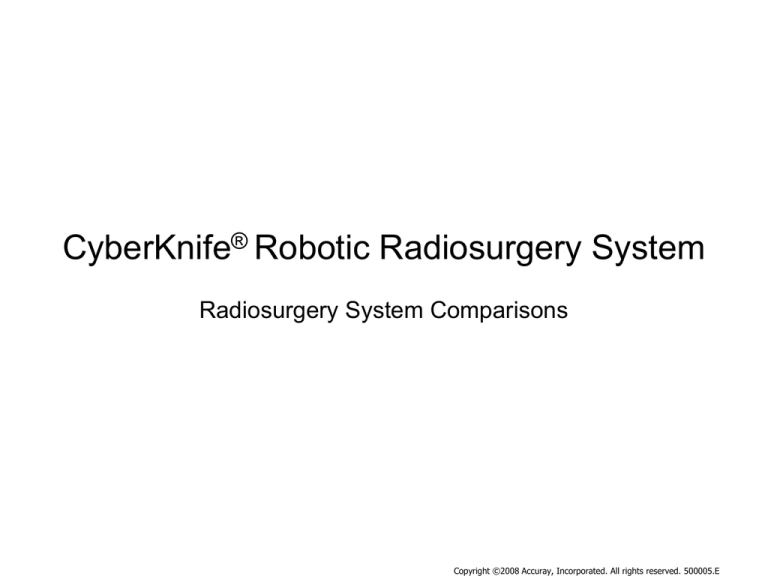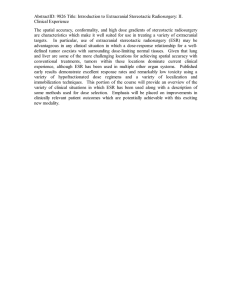
CyberKnife® Robotic Radiosurgery System
Radiosurgery System Comparisons
Copyright ©2008 Accuray, Incorporated. All rights reserved. 500005.E
Radiosurgery and Radiotherapy
Radiosurgery
Radiotherapy
High dose
Low dose
(~ 6 to 25 Gy per fraction)
(~ 2 Gy per fraction)
Typical # of Fractions
1 – 5 fractions
30 – 45 fractions
Typical # of Unique Beams Per
Fraction
150 – 200
5 – 10
Typical Targeting Accuracy
< 1 millimeter
3 – 20 millimeters
Clinical Intent
Tumor ablation
Cumulative dose tumor control
Average Dose Per Fraction
Copyright ©2008 Accuray, Incorporated. All rights reserved. 500005.E
Dose Escalation for Tumor Ablation Necessitates:
Extreme Targeting Accuracy
• Ability to deliver sub-millimeter mechanical accuracy
• Ability to deliver sub-millimeter tumor targeting accuracy
Large Non-Coplanar Beam Delivery
• Ability to diversify beam trajectories to reduce risks of dose toxicity
• Agility to target tumors from a high volume of unique angles
Copyright ©2008 Accuray, Incorporated. All rights reserved. 500005.E
Radiation Delivery System Comparison
Radiation Therapy Systems
Targeting Accuracy
5 – 20 millimeters
Applications
Intracranial and Extracranial
Ability to Fractionate
Unlimited
Image Guidance
Typically limited to MV portal imaging on a weekly
basis
Non-Coplanar Delivery
Capabilities
Limited clockwise / counter-clockwise gantry
mobility enables a single plane typically delivering
7 unique beam angles
Varian Clinac®
Elekta Synergy®
Siemens PRIMUS®
TomoTherapy Hi-ART System®
Additional planes can be achieved with manual
couch yaw rotations. Patient / gantry collision
potential and the impractical nature of manual
patient positioning has resulted in little or no
clinical adoption
Moving Tumor Targeting
Utilizes gating / breath-holding techniques resulting
in large contour margins and unnecessary healthy
tissue exposure
Stereotactic Frames
Immobilization devices used. Low dose per fraction
reduces need for accuracy
Copyright ©2008 Accuray, Incorporated. All rights reserved. 500005.E
Radiation Delivery System Comparison
Radiation Therapy Systems
Radiation Therapy Systems Adapted for Radiosurgery
Targeting Accuracy
5 – 20 millimeters
3 – 20 millimeters
Applications
Intracranial and Extracranial
Intracranial and Extracranial
Ability to Fractionate
Unlimited
Unlimited
Image Guidance
Typically limited to MV portal imaging on a weekly
basis
Image guidance limited to pre-treatment, patient setup only
Non-Coplanar Delivery
Capabilities
Varian Trilogy™
Elekta Axesse™
BrainLAB Novalis®
High resolution kV imaging / cone-beam CT
Limited clockwise / counter-clockwise gantry
mobility enables a single plane typically delivering
7 unique beam angles
Limited clockwise / counter-clockwise gantry
mobility enables a single plane typically delivering 7
unique beam angles
Additional planes can be achieved with manual
couch yaw rotations. Patient / gantry collision
potential and the impractical nature of manual
patient positioning has resulted in little or no
clinical adoption
Moving Tumor Targeting
Utilizes gating / breath-holding techniques
resulting in large contour margins and
unnecessary healthy tissue exposure
Utilizes gating / breath-holding techniques resulting
in large contour margins and unnecessary healthy
tissue exposure
Stereotactic Frames
Immobilization devices used. Low dose per fraction
reduces need for accuracy
Required in most Intracranial & Extracranial cases
Additional planes can be achieved with manual
couch yaw rotations, however without image
guidance due to patient / OBI collisions - resulting in
less than ideal targeting accuracy. Further, the
impractical nature of manual patient positioning has
resulted in little or no clinical adoption
Copyright ©2008 Accuray, Incorporated. All rights reserved. 500005.E
Radiation Delivery System Comparison
Radiation Therapy Systems
Targeting Accuracy
5 – 20 millimeters
Applications
Intracranial and Extracranial
Radiation Therapy Systems Adapted for Radiosurgery
3 – 20 millimeters
Elekta Gamma Knife®
Elekta Perfexion™
American Radiosurgery GammaART-6000™
Intracranial and Extracranial
Dedicated Cobalt 60 Radiosurgery Systems
< 1 millimeter
Intracranial only
Limited spine capabilities (C1 & C2) Perfexion™
only
Ability to Fractionate
Unlimited
Unlimited
Typically limited to a single fraction due to time,
resource, and pain constraints
Image Guidance
Typically limited to MV portal imaging on a weekly
basis
Image guidance limited to pre-treatment, patient setup only
None, relies exclusively on target’s fixed relative
position to the stereotactic frame
Non-Coplanar Delivery
Capabilities
High resolution kV cone-beam CT
Frame mechanical accuracy may introduce 1.21.9 mm error (*Maciunas)
Limited clockwise / counter-clockwise gantry
mobility enables a single plane typically delivering
7 unique beam angles
Limited clockwise / counter-clockwise gantry
mobility enables a single plane typically delivering 7
unique beam angles
Additional planes can be achieved with manual
couch yaw rotations. Patient / gantry collision
potential and the impractical nature of manual
patient positioning has resulted in little or no
clinical adoption
Moving Tumor Targeting
Utilizes gating / breath-holding techniques
resulting in large contour margins and
unnecessary healthy tissue exposure
Utilizes gating / breath-holding techniques resulting
in large contour margins and unnecessary healthy
tissue exposure
N/A
Stereotactic Frames
Immobilization devices used. Low dose per fraction
reduces need for accuracy
Required in most Intracranial & Extracranial cases
Requires invasive frames in all cases
Additional planes can be achieved with manual
couch yaw rotations, however without image
guidance due to patient / OBI collisions - resulting in
less than ideal targeting accuracy. Further, the
impractical nature of manual patient positioning has
resulted in little or no clinical adoption
* RJ Maciunas, RL Galloway Jr, JW Latimer. The application accuracy of stereotactic frames. Neurosurgery 35(4): 682–695, Oct 1994
Hemisphere with fixed collimators enables a noncoplanar workspace capable of delivering a
maximum of 201 (190 Perfexion™) unique beam
angles
Copyright ©2008 Accuray, Incorporated. All rights reserved. 500005.E
Radiation Delivery System Comparison
Radiation Therapy Systems Adapted for
Radiosurgery
Radiation Therapy Systems
Targeting Accuracy
5 – 20 millimeters
Dedicated Cobalt 60 Radiosurgery Systems
3 – 20 millimeters
< 1 millimeter
Accuray Incorporated
CyberKnife® System
Applications
Intracranial and Extracranial
Intracranial and Extracranial
Intracranial only
Limited spine capabilities (C1 & C2) Perfexion™
only
Dedicated Robotic Radiosurgery Systems
< 1 millimeter for stationary tumors
< 1.5 millimeters for moving tumors
Intracranial and Extracranial
Ability to Fractionate
Unlimited
Unlimited
Typically limited to a single fraction due to time, resource and
pain constraints
Unlimited
Image Guidance
Typically limited to MV portal imaging on a weekly
basis
Image guidance limited to pre-treatment, patient
set-up only
None, relies exclusively on target’s fixed relative position to the
stereotactic frame
Continual image guidance throughout the treatment
Frame mechanical accuracy may introduce 1.2-1.9 mm error
(*Maciunas)
Hemisphere with fixed collimators enables a noncoplanar workspace capable of delivering a maximum
of 201 (190 Perfexion™) unique beam angles
Robotic mobility enables a large non-coplanar
workspace capable of seamlessly delivering
more than 1200 unique beam angles without
treatment interruption or the need to manually
reposition the patient
Non-Coplanar Delivery
Capabilities
Limited clockwise / counter-clockwise gantry
mobility enables a single plane typically delivering 7
unique beam angles
Additional planes can be achieved with manual
couch yaw rotations. Patient / gantry collision
potential and the impractical nature of manual
patient positioning has resulted in little or no clinical
adoption
High resolution kV imaging / cone-beam CT
Limited clockwise / counter-clockwise gantry mobility
enables a single plane typically delivering 7 unique beam
angles
Additional planes can be achieved with manual couch yaw
rotations, however without image guidance due to patient /
OBI collisions - resulting in less than ideal targeting
accuracy. Further, the impractical nature of manual patient
positioning has resulted in little or no clinical adoption
High resolution kV imaging
Automatically track, detect and correct for tumor and
patient movement
Moving Tumor Targeting
Utilizes gating / breath-holding techniques resulting
in large contour margins and unnecessary healthy
tissue exposure
Utilizes gating / breath-holding techniques resulting in large
contour margins and unnecessary healthy tissue exposure
N/A
Delivers tightly contoured beams synchronized
precisely to tumor motion resulting in minimal healthy
tissue exposure
Stereotactic Frames
Immobilization devices used. Low dose per fraction
reduces need for accuracy
Required in most Intracranial & Extracranial
cases
Requires invasive frames in all cases
No frame required
* RJ Maciunas, RL Galloway Jr, JW Latimer. The application accuracy of stereotactic frames. Neurosurgery 35(4): 682–695, Oct 1994
Copyright ©2008 Accuray, Incorporated. All rights reserved. 500005.E












